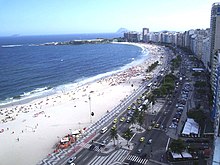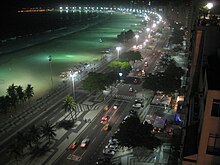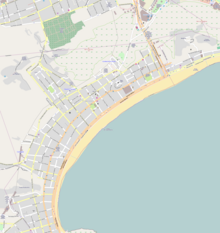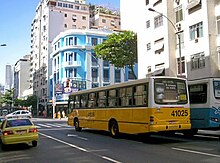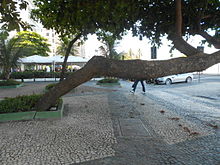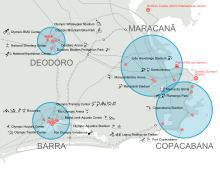Copacabana (Rio de Janeiro)
| Copacabana | |
|---|---|
| Coordinates | 22 ° 58 '15 " S , 43 ° 10' 54" W |

|
|
| Basic data | |
| Country | Brazil |
| Rio de Janeiro | |
| city | Rio de Janeiro |
| ISO 3166-2 | BR-RJ |
| Sub-prefecture | Zona Sul |
| surface | 4.1 km² |
| Residents | 146,392 (2010) |
| density | 35,697.5 Ew. / km² |
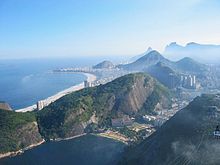
Copacabana is one of the most famous districts of Rio de Janeiro in the Zona Sul , which lies directly between the Atlantic Ocean and the granite rocks populated with favelas and has a four-kilometer-long sandy beach . Together with the neighboring Leme , the district also forms the administrative region of the same name, Copacabana.
Location and demographics
The northern part of Copacabana (here a neuter because a residential area, not like in Bolivia , where Copacabana is a peninsula, so feminine) forms the independent quarter Leme , which ends with the Chapeu (hat) Mangueira and the Morro do Leme . Leme is a predominantly upscale neighborhood, which is inhabited by the upper class. To the south, at the transition to the Ipanema district , is the Arpoador district . In the west is the Lagoa Rodrigo de Freitas and in the north Botafogo . On the border are the small Mangueira district, known for its carnival school, and the São João Batista cemetery . Access to Copacabana from the north is possible through road tunnels.
Copacabana is 5.08 km² in size and currently has the highest population density in Rio with 34,000 inhabitants per km².
About 300,000 people live in the 109 streets of Copacabana. Copacabana comprises 101 street blocks, 79 streets, seven side streets, four slopes and three favelas ( Pavão-Pavãozinho , Favela Morro dos Cabritos and Ladeira dos Tabajaras ) in an area of 7.84 square kilometers. It is compared to a “melting pot” rich in contrasts, as there is a strong mix of ethnicities and classes , which is unique in the world. " Copacabana shows the ethnic, cultural and social diversity of Brazilian society ." In contrast to the neighboring district of Ipanema, which is traditionally assigned to the upper class, Copacabana is predominantly inhabited by the middle and upper middle class. This district has the largest proportion of seniors and retirees in Rio de Janeiro. Copacabana has several underground stations: Cardeal Arcoverde , Siqueira Campos and Cantagalo are within the boundaries of the Copacabana district; while General Osório lies exactly on the border with Ipanema.
The Portuguese Avenida Atlântica (Atlantikallee) is the boulevard that connects directly to the beach, Praia de Copacabana. Its sidewalk consists of the famous, wavy, curved mosaics that are characteristic of Copacabana. Well-known star hotels, which are located directly on Avenida Atlântica, are the Rio Palace , the 37-story Windsor Atlantica (in Leme), the Othon Palace Hotel and the Copacabana Palace . The tourist scene is concentrated on Avenida Atlântica with a large number of street cafes and restaurants.
history
The district was originally called Sacopenapã (translated from the Tupi language, means "the way of the Sozós", whereby the Sozós is a kind of bird) until the middle of the 18th century. It was renamed after a chapel was built with a replica of the Virgen de Copacabana, Mother of God of Bolivia . The original Copacabana Beach, the place of origin of the Mother of God Copacabana, is located on Lake Titicaca . Its name is explained on the one hand from the native language as “view of the lake”, but it could also be derived from the name of an ancient water deity who was similar to Aphrodite or Venus . In the 1930 and 1940s , Copacabana achieved an internationally recognized heyday for the first time, as Copacabana became the epitome of the “rich and beautiful”. A number of upscale hotels, restaurants and night clubs have sprung up in the fashionable seaside resort.
The crescent-shaped, around 4 km long beach (almost 1 km of which is Leme Beach ) with the promenade is also called "Princesinha do Mar" (Little Sea Princess) and saw its golden age in the 1930s, 1940s and 1950s . As a district of bohemianism , wealth and glamor, Copacabana has become the subject of many pieces of music, books and pictures.
The neighborhood has many restaurants, cinemas and theaters. With the successive replacement of the villas with ten to twelve-story apartment blocks, the population density has increased sharply since the 1960s. Therefore Copacabana is very dense today, nevertheless it is one of the most attractive areas with more than 70 hotels that attract many tourists.
Main streets
Trade and commerce, fashion stores such as Athleta do Pé, Fabricatto, Perla & Cia., Sula Drey and Yes Brazil and others are concentrated around the Avenida Nossa Senhora de Copacabana and Rua Santa Clara area. There are also numerous banks, cinemas, money exchange offices, churches and synagogues . Souvenir shops can be found in the streets around Rua Paula Freitas and Praça Bernadelli near the Hotel Copacabana (which is marked purple-gray near the center of the adjacent map). In some places there are weekly and street markets on Rua Decio Vilares on Sunday, Rua Gustavo Sampaio on Monday, Rua Belford Roxo and Rua Ronaldo de Carvalho on Thursday and Rua Domingos Ferreira on Wednesday. The street market on Avenida Atlântica starts every day after nightfall.
- Avenida Atlântica: Copacabana promenade
- Avenida Nossa Senhora de Copacabana: The main street of Copacabana, which crosses the district, is one of the streets in the Zona Sul with the most traffic problems
- Avenida Princesa Isabel: connects the Copacabana, Leme and Botafogo neighborhoods
- Avenida Rainha Elizabeth da Bélgica: connects the Copacabana and Ipanema districts
- Avenida Prado Júnior
- Rua Barata Ribeiro: crosses Copacabana, is one of the busiest streets along with Avenida Nossa Senhora de Copacabana. "Rua Barata Ribeiro is hectic and hard to beat in terms of noise and stench, because all the bus traffic from the center to the southern districts rolls through the street in a never-ending column."
- Rua Coelho Cintra: then known as Antiga Ladeira do Leme, connects the Copacabana and Botafogo districts
- Rua Toneleros
- Rua Pompeu Loureiro: connects the Copacabana and Lagoa districts
- Rua Raul Pompeia
- Rua Siqueira Campos
- Rua Figueiredo de Magalhães: connects the Copacabana and Botafogo neighborhoods
- Rua Santa Clara
tourism
Copacabana and the beach that goes with it are strongly influenced by international tourism. The skyline on Avenida Atlântica is characterized by large luxury class hotels such as the Copacabana Palace, Hotel Rio Othon Palace, Windsor Atlantica Hotel, Porto Bay Rio Internacional Hotel, Pestana Rio Atlantica, JW Marriott Hotel and many more. At some distance from the beach there are middle-class hotels, apartment apartments, guest houses, hostels, bed & breakfast guest houses and a youth hostel. Well-known and traditional restaurants are z. B. the Arataca in the Rua Figueiredo Magalhaes 28, the Bec Fin in the Av. Nossa Senhora de Copacabana, the Caranguejo in Rua Barata Ribeiro 771, the Confeitaria Colombo in the Barão de Ipanema 890, the Churrascaria Jardim, Rua República do Perú, the Meriu's in Av. Atlântica 290, the La Mole on Av. Nossa Senhora de Copacabana 552 and the O Peixe Vivo in Rua Toneleros 76. Another specialty are the “Comida a Kilo” self-service restaurants.
Attractions
The most famous attraction of Copacabana is the beach with the four kilometer long Calçadão de Copacabana, designed by Burle Marx in 1970, along Avenida Atlântica. Other sights include the Forte de Copacabana , an originally military complex, which today houses the Museu Histórico do Exército (Historical Museum of the Army ). The Serzedelo Correia square, Edmundo Bittencourt square, the Dorival Caymmi statue, the somewhat remote Praia do Diabo and the Cassino Atlântico shopping center are some of the other attractions in the area.
Beach life
On the border with Ipanema is the legendary Posto 6 beach kiosk (lifeguard post), where some traditional fishermen go about their business. Posto 6 is the meeting place for the people of Copacabana, who meet there to exchange views, play cards and play board. The beach and the promenade are visited by a large number of outpatient traders, which goods of various kinds such as. B. sell sunscreen, towels, mate or coconut water. Football and beach volleyball can sometimes be played under floodlights on the beach at night. The beach of Copacabana with its white sand and its cleanliness enjoys world fame and is symbolic of the place where sport, joie de vivre and the body cult of Brazil are celebrated. The Atlantic Ocean has strong currents at times on the beach section of Copacabana. Swimming is prohibited in strong undercurrent. In addition, there is often strong surf and a relatively steep drop on the shore zone, which makes swimming not entirely safe. During the day, swimming is monitored by lifeguards who are posted on observation towers.
2016 Summer Olympics
The beach volleyball arena (in Portuguese Arena de Vôlei de Praia ) was the temporary venue for beach volleyball at the 2016 Olympic Games in Rio de Janeiro. The arena is located on Copacabana Beach, the cradle and center of Brazilian beach volleyball. It is located on Avenida Atlântica at the level of Avenida Princesa Isabel . The sports facility has a capacity of 12,000 spectators. In addition to the main playing field (center court), the facility includes five training and two warm-up courts.
At Forte Copacabana , the road race in cycling, triathlon and long-distance swimming was held at the Olympic Games. At the Paralympics 2016 it was the start and finish for the triathlon and the marathon.
Events
Around New Year's Eve (Reveillon) and on other occasions, Copacabana is often used as a backdrop for major events, some of which the quarter is frequented by over a million visitors. At the turn of the year it is customary to throw offerings into the sea to the sea goddess Iemanjá . Many white-clad followers of the Afro-Brazilian cults Candomblé and Macumba come together to celebrate this ceremony on New Year's Eve. On New Year's Eve, large-scale fireworks and classical concerts by performers such as Luciano Pavarotti are organized by the city administration. On February 18, 2006, the Rolling Stones performed in front of over a million listeners on Copacabana Beach , with no admission fee charged. A concert on July 7, 2007 as part of the “ Live Earth ” festival was also free of charge .
With the help of red balloons it was signaled in June 2008 in a sensational action on the beach area that by then in 2008, 4,000 residents of Rio de Janeiro had already died from firearms.
On July 28, 2013 Pope Francis celebrated the closing service of the XXVIII on the beach. World Youth Day , attended by around 3.2 million people.
Major events in Copacabana
- Show Rod Stewart (1994)
- Show Rolling Stones , Titãs and AfroReggae (2006)
- Show Live Earth (2007)
- Show Claudia Leitte (2008)
- Show Roberto Carlos (2010)
- Exhibition " United Buddy Bears - A Arte da Tolerância" (2014)
nightlife
One of the most famous nightlife spots in Copacabana was the Help large-capacity disco, which opened in 1984 on the corner of Avenida Atlântica No. 3432 and Rua Dijalma Ulrich, and was the largest disco in Latin America at the time. For a long time the “Help” was regarded as a notorious contact point between Brazilian prostitutes and foreign tourists. It was also used as a hub for drugs. The demolition of the discotheque began in 2011, after the city prefecture initiated a lawsuit against it in 2008. The MIS, the Museu da Imagem e do Som, was built in its place. Other well-known dance halls and discos are the Columbus on Rua Paul Pompeia 94, the Sobre as Ondas on Avenida Atlântica No. 3432 and the Vinicius on Av. Nossa Senhora de Copacabana 1144. Large hotels such as the Rio Palace, the Meridien and the Othon Palace have some luxurious piano bars. In 2010 the internationally known ON11 Nightclub was opened in Rua Francisco Otaviano 20a, which can accommodate 1,000 guests and is based on European club standards.
prostitution
For a long time, Copacabana was a travel destination for sex tourism, which is now heavily regulated by the authorities. Prostitution takes place in the red light zone on the border with the Leme district around the streets Av. Princesa Isabel, Av. Prado Junior, Rua Belford Roxo and Rua Duvivier. It is concentrated from the Hotel Lancaster to the Hotel Meridien.
crime
Since Copacabana is also a well-known entertainment district and is visited by many tourists, the crime rate of theft is relatively high. In recent years there has been an increase in the formation of youth gangs who deliberately rob tourists. These gangs are called "Uté" by the locals. On a few days, street children attack overcrowded stretches of beach in large numbers and commit a robbery called “arrastão”, in which all valuables are taken away from bathers within a very short time.
However, a strong presence of the military police ensures that crime is minimized in the flagship district of Rio de Janeiro. The local press commented on the rape of a tourist: "At Disneyland, nobody expects to be attacked, tied up and mixed up," said the chairman of the Brazilian hotel association, Alfredo Lopes, of the newspaper O Globo . “Copacabana is our Disneyland.” After Recife and Vitória, Rio de Janeiro is one of the most dangerous cities in Brazil when it comes to violent crime. However, Copacabana has the lowest index in Rio de Janeiro with a homicide rate of 2.4 cases per 100,000 people.
Personalities
Copacabana is the home and place of work of a large number of public figures in Brazil:
President
- Eurico Gaspar Dutra
- João Café Filho
- Carlos Coimbra da Luz
- Nereu Ramos
- Juscelino Kubitschek
- João Goulart
- Pascoal Ranieri Mazzilli
- Emílio Garrastazu Médici
- Tancredo Neves
Governors
Minister of State
- Marcelo Caetano - Presidente do Conselho de Ministros de Portugal
- Afrânio de Melo Franco
- Henrique Teixeira Lott
- Armando Falcão
- Celso Furtado
- Horacio Lafer
- Lira Tavares
- Lucas Lopes
- Odílio Denys
- Otávio Gouveia de Bulhões
- Otávio Gondin
Other personalities
- Assis Chateaubriand - journalist
- Cláudio G. Avelar de Araújo - businessman and politician
- Ângela Rô Rô - singer and composer
- Bernardo Rezende - ex-volleyball player and coach
- Rosa Magalhães - Carnival personality
- Dorival Caymmi - composer
- Augusto Frederico Schmidt - writer
- Maysa - singer and composer
- Paulo Coelho - writer
- Guto Graça - writer
- Jorge Amado - writer
- Jorge Rios - teacher and writer
- Carlos Drummond de Andrade - poet and writer
- Ferreira Gullar - writer
- Billy Blanco - composer
- Clóvis Bornay - Carnival personality
- Mário Lago - actor and composer
- Neguinho da Beija-Flor - singer and composer
- Josué Montello - writer
- Joel Silveira - journalist
- Cauby Peixoto - singer
- Darcy Ribeiro - sociologist
- Dercy Gonçalves - actress
- Braguinha - composer
- Bruno Medina - musician
- Marta Rocha - Ex-Miss Brazil
- Jade Barbosa - gymnast
- Júnior - ex-soccer player
- Jairzinho - ex-soccer player
- Roberto d'Ávila - journalist
- Aniz Abraão David - Patron of the Beija-Flor Carnival Society from Nilópolis
- Nelson Motta - composer and writer
- Nelson Sargento - composer
- Elis Regina - singer
- Elza Soares - singer
- Emilinha Borba - singer
- Eduardo Dussek - actor, singer and composer
- Milton Banana - drummer and composer
- Angela Maria - singer
- Roberto Menescal - composer
- Marcelo Caetano - politician
- Veiga da Cunha - politician
- Narcisa Tamborindeguy - celebrities
- Glauco Rodrigues - plastic artist
- João Roberto Kelly - composer
- Julio Bogoricin - businessman
- Henri Salvador - singer
- Eneida de Moraes - writer
- Elias Nogueira - journalist
- Ronald Schill - Ex-politician & ex-Interior Senator of the Free and Hanseatic City of Hamburg
Web links
- Old postcards from Copacabana ( Memento from August 10, 2015 in the Internet Archive ) (Portuguese / English)
- Live webcam Rio de Janeiro, Copacabana Beach, view over the beach to Sugar Loaf
- Spiegel Online, Traumstrand: The Copacabana Lifestyle, July 22, 2002
- Copacabana Tourism Website
- Mapa das Competições. Comitê Organizador Rio 2016, accessed June 29, 2016 .
Notes and individual references
- ↑ Bairros. Prefeitura da Cidade do Rio de Janeiro, 2010, archived from the original on September 2, 2013 ; Retrieved January 5, 2014 .
- ↑ Data from 1990.
- ↑ a b c d e f g h i Angela Allemann: Rio de Janeiro. Regenbogen-Verlag, 1990, ISBN 3-85862-048-3 .
- ↑ pt. - Goat Mountain
- ↑ Rio for Partiers ( Memento from April 15, 2014 in the Internet Archive )
- ↑ pt. Kitchenete - eat-in kitchen
- ↑ official homepage Forte de Copacabana
- ↑ pt. - Devil's Beach
- ↑ pt. Camelôs
- ^ Body cult on Sugar Loaf. In: Die Welt am Sonntag. June 27, 2010.
- ↑ Two million people expected for the Copacabana New Years Eve party. In: Augsburger Allgemeine.
- ^ Jens Glüsing: Rolling Stones in Rio. Dance with the devils. In: Der Spiegel. February 19, 2006.
- ↑ Balloons for the dead. ( Memento from July 11, 2008 in the Internet Archive ) In: Frankfurter Allgemeine Zeitung . June 27, 2008 (photography): “4000 red balloons rise at Copacabana. Demonstrators remember the 4,000 residents of Rio de Janeiro who died from firearms this year. "
- ↑ The highlights of the year "Germany + Brazil 2013–2014" in Rio ( Memento from November 5, 2014 in the Internet Archive )
- ^ Rio nightclub closure leaves prostitutes Helpless The Guardian, August 17, 2009
- ↑ Will the famous “Discoteca Help” on Copacabana be closed? on: rioapartment.wordpress.com , October 15, 2008.
- ^ MIS Set to Replace Club Help in Copacabana. In: The Rio Times. January 11, 2011 (en.)
- ↑ MIS Homepage (pt.) Museum for Image and Sound
- ↑ Rio Times Online, November 30, 2011
- ↑ Made in Brazil, Dangerous Copacabana
- ↑ pt. Organized raid, looting
- ↑ Klaus Hart: Brazil's tourism boom and violent crime, "Foreigners don't notice anything about the war in the slums". ( Memento from September 22, 2014 in the Internet Archive )
- ↑ Shock After Rape - How Safe Is Rio? In: The world. April 4, 2013.
- ↑ UOL Noticias, June 2, 2012 (pt.)
- ↑ Crime map of the metropolitan area of Rio de Janeiro (pt.) ( Memento from November 25, 2011 in the Internet Archive )

